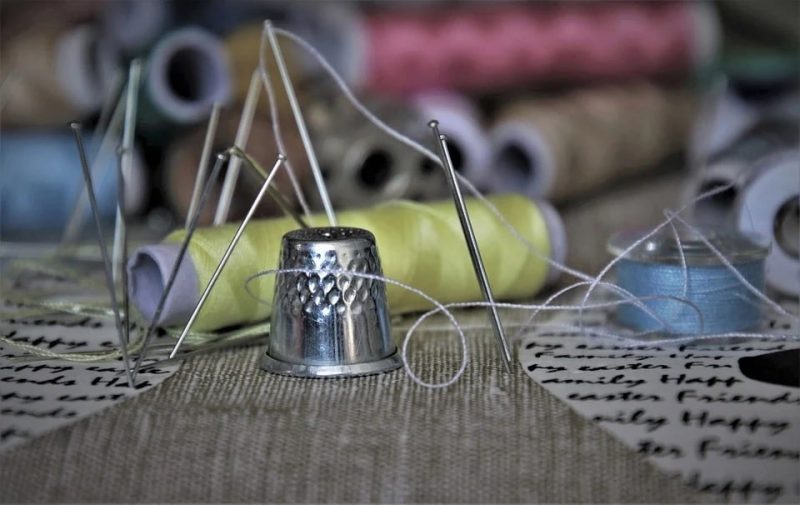You can learn how to hand sew a pillow in two simple steps. This will be a useful skill to have because you can experiment with different materials and pillow sizes. However, this guide is for your typical bed pillow, so feel free to modify it according to the shape you’re making.
Besides a pillow insert, it’s also common to make the pillow yourself at home. It gives you the freedom to customize a pillow to suit your needs and guarantee the best sleep quality. Furthermore, why not impress your friends by making them pillows as gifts?

How To Make A Hand-Sewn Pillow
Step #1. Make a pattern
Making a pillow yourself gives you complete freedom over its shape, size, and design. Therefore, before sewing, the first step is making the pattern and cutting the fabric pieces for the pillow. If you already have a pillow form, you can use the exact measurements or use any size you like.
Cut two pieces of fabric that will make the front and back sides of your pillow. Then, pin the bottom edge of these fabric pieces with their right sides together and wrong sides facing out. You can make sewing easier by pinning two inches from one corner and end it two inches from the other corner of the bottom side.
Step #2. Sewing
The final step is sewing itself, and you can start where you placed the first pin at the bottom edge of the pillow liner. A useful tip is bringing the needle upward and then moving it over 1/8 inches before sewing back to the liner’s bottom side. You should easily sew around the pillow, but remember to leave two inches open for turning the pillow liner right side out.
When making knots, you want to include a bit of fabric to where you want to place your next thread. Then, leave a small thread loop and pull your needle through it for added security. Clip the four corners of the pillow and turn it right side out.
You can then stuff the pillow with your choice of filling and amount to reach your desired firmness and loft. Remember always to check if the pillow is snug and has no spaces inside. Then, pin the opening and stitch it closed with a ladder stitch or use a different type of closure like a zipper if you don’t want to permanently shut the pillow.
Common Types Of Pillows
Before anything else, it’s worth noting that some pillow types may overlap. One can consider a body pillow a bed pillow, a bolster pillow as a body pillow, or a wedge pillow as a pregnancy pillow. Some bed pillows can also become decorative pillows like the European pillow.
Bed pillow
When we think of a bed pillow, the standard-size one comes to mind. You can also find other rectangular bed pillows in king and queen sizes. However, you can think of any pillow as a bed pillow, so don’t be confused when choosing pillows in the market.
Body pillow
Body pillows are larger pillows that are meant to support various body regions and maintain a good sleeping posture. Still, there are body pillows from various brands that are smaller and target specific areas in the body. In general, anything that supports the body and influences the sleeping position can be a body pillow.
Pregnancy pillow
Pregnancy pillows look like body pillows, but they come in different shapes and sizes to support pregnant women. They can relieve the pressure on the back and stomach and maintain the ideal side sleeping position during pregnancy. Some pregnancy pillows can even become nursing pillows and are usable postpartum.
Bolster pillow
Bolster pillows or roll pillows are cylindrical pillows that you can use as decorations and support the body. You can place them under the neck or legs to keep the body aligned. Bolster pillows come in various shapes and sizes, and you can sometimes find them labeled as body and pregnancy pillows.
Wedge pillow
Another good pillow for elevation is the wedge pillow. You can find it in different sizes, and even pregnant women can benefit from it. Furthermore, a wedge pillow is useful for relieving pain, acid reflux, and breathing issues thanks to its angle.
European pillow
Decorative pillows come in different shapes and sizes to improve the look of the bed or couch. However, the most popular one is the square-shaped European pillow. It’s not limited to being a decorative piece because it can work as an additional cushion.
Conclusion
You don’t need a sewing machine to make a pillow at home. You can quickly learn how to hand sew a pillow using two simple steps. Start by designing and measuring your pillow and cut two fabric pieces accordingly.
You should end up with the front and back sides of your pillow. Pin them together for easier sewing and then stitch around the pillow. Be mindful of how secure you’re sewing, and leave a gap for turning the pillow later.
Finally, you should be ready to stuff the pillow accordingly. Don’t forget to check its firmness and loft before you stitch the opening close. It’s also worth noting that you can make other types of pillow closures if you want to adjust or replace the stuffing later on.
